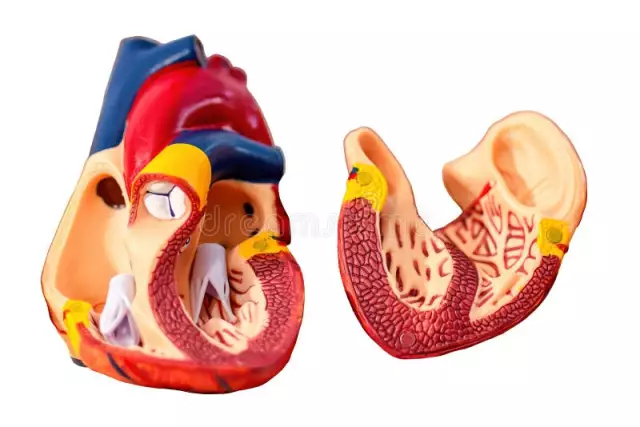- Author Curtis Blomfield [email protected].
- Public 2023-12-16 20:44.
- Last modified 2025-01-23 17:01.
An important characteristic of the work of the heart muscle is the automatism of contractions. The well-coordinated work of the heart, which is based on successive contractions and relaxations of the muscle tissue of the atria and ventricles, is regulated by a cellular structure with a complex structure that conducts nerve impulses.

The conduction system of the heart is the most important mechanism for ensuring the life of the human body, consisting of a pulse generator (pacemaker) and individual complex formations designed to innervate the cycles of the myocardium. Consisting of a cellular structure based on the work of P-cells and T-cells, it is designed to initiate the heartbeat and coordinate the contraction of the heart chambers. The first type of cells has an important physiological function of automaticity - the ability to rhythmically contract without a clear connection with the impact of any external stimuli.
T cells, in turn,have the ability to transmit contractile impulses generated by P-cells to the myocardium, which ensures its smooth operation. Thus, the conducting system of the heart, whose physiology is based on the coordinated interaction of these two groups of cells, is a single biological mechanism that is structurally part of the cardiac apparatus.

The conduction system of the human heart consists of several functional components: the sinoatrial and atrioventricular nodes, as well as the bundle of His with the right and left legs, ending with Purkinje fibers. The sinoatrial (sinus) node, located in the region of the right atrium, is a small mass of elliptical muscle fibers. It is in this component, from which the conduction system of the heart begins, that nerve impulses are born that cause contractile reactions of the whole heart. Normal automatic sinoatrial node is considered to be from fifty to eighty impulses per minute.
The atrioventricular component, located below the endocardium in the posterior segment of the interatrial septum, performs an important function of delaying, filtering and redistributing incoming impulses generated and sent by the sinoatrial node. The conduction system of the heart also performs the regulatory and distributive functions assigned to its structural component - the atrioventricular node.

The need for such functions is due to the fact that a wave of nerve impulses, instantlyspreading through the atrial system and causing their contractile response, it is not able to immediately penetrate into the ventricles of the heart, since the atrial myocardium is separated from the ventricles by fibrous tissue that does not transmit nerve impulses. And only in the area of the atrioventricular node such an insurmountable barrier is absent. This causes a wave of impulses to rush to this important component in search of a way out, where they are evenly distributed throughout the heart apparatus.
The conduction system of the heart also contains in its structure a bundle of His connecting the atrial and ventricular myocardium, and Purkinje fibers that form synapses on cardiomyocyte cells and provide the necessary conjugation of muscle contraction and nervous excitation. At their core, these fibers are the final branching of the bundle of His, attached to the subendocardial plexuses of the ventricles of the heart.






